#124: Galerina marginata, the Deadly Galerina
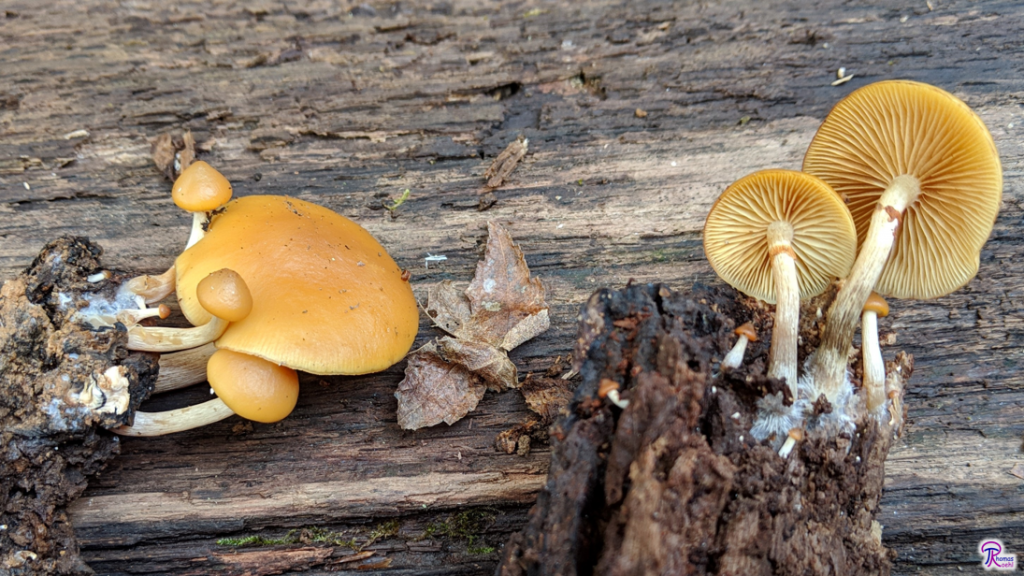
If you are collecting for the table, this is one little brown mushroom (LBM) that you should definitely know. Most LBMs go unnoticed because they are heard to spot and are usually too small to consider worth eating. The “Deadly Galerina” is therefore usually not dangerous on its own. The real danger from this mushroom comes when it is accidentally collected along with a group of edible mushrooms. Galerina marginata contains amatoxins, which are also found in such infamous species as the Destroying Angels (Amanita virosa complex, FFF#050) and Death Caps (Amanita phalloides, FFF#051). In England, G. marginata goes by the beautifully ominous name, “Funeral Bell.” Unfortunately for me, people in the United States prefer the much blander common name, “Deadly Galerina.”1–3
Description
G. marginata is a little brown mushroom that grows on wood. Since LBMs are often difficult to tell apart, NEVER EAT ANY LBM GROWING ON WOOD! Apparently, there is an Italian rule of thumb that states that no poisonous mushrooms grow on wood. Certainly, the Deadly Galerina disproves that rule!3
The Deadly Galerina is an umbrella-shaped agaric with a circular pileus and central stalk. Its cap is 1.5-7cm wide, brown to yellow-brown to tan, and convex to flat (and sometimes bell-shaped). In fresh specimens, the pileus usually has a nice, even curve so that it is nearly hemispherical. The pileus does not have any decorations but is slimy when wet and can become paler in patches when it dries out. You may notice that the margin is lighter than the center of the cap and is slightly lined; these features are alluded to by the species name “marginata.”1,2,4,5
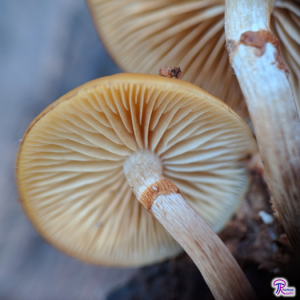
Underneath the cap, the gills are attached but may run down the stipe just a bit. The gills are yellowish when young but become brown with the maturing spores. If you catch the mushroom when it is very young, the gills will be covered with a whitish partial veil. This veil collapses around the stalk early, so this is usually something you usually don’t find it. The Deadly Galerina’s spore print is medium brown.1,2,4,5
G. marginata features a 2-10cm long stipe that is fairly thin and roughly the same width all the way down. The stipe is usually light brown (about the same color as the gills) near the tip and darkens to greyish black near the base and with age. It is mostly smooth but is often covered in white fibers and has a ring or faint ring zone that sometimes disappears. The fragile cottony ring is what remains of the partial veil. This feature is one of the most helpful physical features of the Deadly Galerina. In most specimens, the ring zone catches some of the falling spores to become rusty brown. This is a very helpful feature for identification, but you can’t rely on it all the time.1,2,4,5
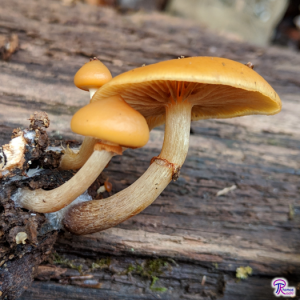
Ecology
The Deadly Galerina can be found all across the northern hemisphere’s temperate zone. Europe, Asia, and North America are all home to this deadly mushroom.2 It appears to be less common in Europe,2 which might explain how the Italian rule of thumb has lasted so long.
As mentioned previously, G. marginata grows from decaying wood. Unlike most wood decay fungi, the Deadly Galerina decomposes both hardwood and conifer logs.1,5 They usually grow in loose clusters and often have curved stipes as a result. G. marginata most frequently appears in the spring and fall, but occasionally grows in other seasons as well.1,5 Its habitat and season overlap with all other LBMs, so you must always be vigilant when collecting brownish mushrooms from wood.
Similar Species
Most cases of G. marginata poisoning are accidents. Little brown mushrooms are usually overlooked by mushroom collectors because many are mildly poisonous and generally not appetizing. The majority of people who consume the Deadly Galerina unknowingly pick it up while collecting known edibles.3 Honey Mushrooms (Armillaria spp.), Enokitake or the Velvet Foot Mushroom (Flammulina velutipes), Brick Caps (Hypholoma sublateritium), and Magic Mushrooms (Psilocybe spp.) are the species most commonly confused with the G. autumnalis. All of these species can be found on decaying wood, which is also the habitat of G. marginata. As a result, you should closely examine every single fruiting body you collect for the table.3,4
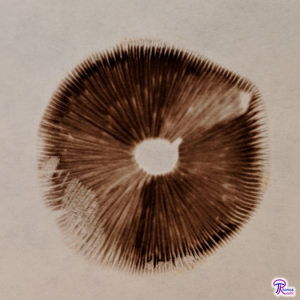
This past fall I found a lot of G. marginata as well as Armillaria gallica on downed logs. Both of these are medium-sized brown mushrooms that appear in small clusters.1,6 Because of this A. gallica is probably the edible mushroom most similar to the Deadly Galerina in my area. An easy way to separate the two species is by taking a spore print: A. gallica has a white spore print. A. gallica also has a bulbous base, fibers on the cap, and yellowish fuzz covering the lower part of the stipe.6 Other species of Armillaria are also similar, but usually fruit in dense clusters. They also have white spore prints, so taking a spore print is always a good way to distinguish G. marginata and Armillaria species.7
Flammulina velutipes (FFF#071) also fruits in dense clusters in the fall and winter. Typically, that mushroom produces lots of individual mushrooms from the same point, whereas G. marginata usually has just a few mushrooms with their bases touching. F. velutipes also tends to be more orangish (though it can be brown), drops white spores, lacks a ring, and features a stipe covered in black velvety fuzz. Once again, if you’re confused you can always check the spore print color.8
Hypholoma sublateritium (FFF#125) is another edible mushroom that fruits in clusters from downed logs in the fall. The Brick Cap features reddish colors on its cap, usually appears in very dense clusters, and has a purple-brown spore print.9 These features should make it easy to distinguish from the Deadly Galerina, just make sure you don’t pick up some G. marginata mushrooms while scooping up Brick Caps.
Psilocybe mushrooms can also be confused with G. marginata. Like Hypholoma, Psilocybe has a purplish spore print that will easily separate it from the medium-brown spores of G. marginata.4,10
Toxicity
G. marginata produces the same type of poisons found in deadly Amanita species: amatoxins. These toxins are especially dangerous because they do not produce symptoms for 6-24 hours. Because of this delayed onset of symptoms, the sufferer may not realize that the mushrooms they ate earlier are the culprits. Initial symptoms resemble food poisoning. The symptoms gradually worsen until the third day, where there is a short remission. If someone who went to the hospital for their symptoms without knowing that mushrooms were the culprit, they may think they are cured and return home at this point. Unfortunately, the symptoms return the next day. After a week or so, the liver and then kidneys fail. Amatoxin poisoning will ultimately result in death if a liver transplant is not performed.11 A drug called Silibinin, which is derived from the Milk Thistle, has shown promise in treating amatoxin poisoning if it is administered soon after symptoms begin.12,13 For more information on amatoxins, see FFF#091.
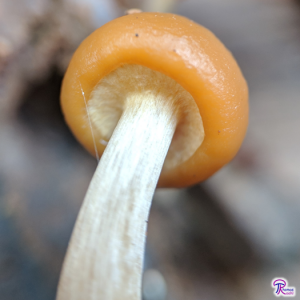
The ratio of each type of amatoxin in G. marginata appears to vary widely (unlike Amanita mushrooms, which all produce about the same amount of toxins). Some Deadly Galerina mushrooms have been found to contain more amatoxins than Death Cap (Amanita phalloides) mushrooms! Apparently, this variation depends upon the substrate and environmental conditions.14 Despite variable amatoxin levels, all G. marginata mushrooms are deadly and should be avoided. Even small pieces of the mushrooms can contain enough amatoxins to kill an adult.3
Taxonomy
Recently, a number of Galerina species were found to be genetically identical. In a reversal of normal trends in mycology, DNA evidence showed that – despite differences in morphology – the five Galerina species found across Europe and North America belong to the same genetic species, G. marginata. As a result, many North American field guides still use the name G. autumnalis instead of G. marginata.1
| Kingdom | Fungi |
| Subkingdom | Dikarya |
| Division (Phylum) | Basidiomycota |
| Subdivision (Subphylum) | Agaricomycotina |
| Class | Agaricomycetes |
| Subclass | Agaricomycetidae |
| Order | Agaricales |
| Family | Strophariaceae |
| Genus | Galerina |
| Species | Galerina marginata (Batsch) Kühner15 |
This post is not part of a key and therefore does not contain enough information to positively identify any mushroom. When collecting for the table, always use a local field guide to identify your mushrooms down to species. If you need a quality, free field guide to North American mushrooms, I recommend Michael Kuo’s MushroomExpert.com. Remember: when in doubt, throw it out!
See Further:
http://www.mushroomexpert.com/galerina_marginata.html http://botit.botany.wisc.edu/toms_fungi/may2003.html http://www.first-nature.com/fungi/galerina-marginata.php http://www.messiah.edu/Oakes/fungi_on_wood/gilled%20fungi/species%20pages/Galerina%20autumnalis.htm https://nature.mdc.mo.gov/discover-nature/field-guide/deadly-galerina http://www.mykoweb.com/CAF/species/Galerina_marginata.html https://www.tandfonline.com/doi/abs/10.1080/15572536.2005.11832920Citations
- Kuo, Michael. Galerina marginata. MushroomExpert.Com (2016). Available at: http://www.mushroomexpert.com/galerina_marginata.html. (Accessed: 2nd February 2019)
- O’Reilly, P. Galerina marginata (Batsch) Kühner – Funeral Bell. First Nature Available at: https://www.first-nature.com/fungi/galerina-marginata.php. (Accessed: 2nd February 2019)
- Volk, T. J. Tom Volk’s Fungus of the Month for May 2003. Tom’s Volk’s Fungi (2003). Available at: http://botit.botany.wisc.edu/toms_fungi/may2003.html. (Accessed: 2nd February 2019)
- Wood, M. & Stevens, F. California Fungi—Galerina marginata. The Fungi of California Available at: http://www.mykoweb.com/CAF/species/Galerina_marginata.html. (Accessed: 2nd February 2019)
- Emberger, G. Galerina marginata. Fungi Growing on Wood (2008). Available at: https://www.messiah.edu/Oakes/fungi_on_wood/gilled%20fungi/species%20pages/Galerina%20autumnalis.htm. (Accessed: 2nd February 2019)
- Kuo, M. Armillaria gallica. MushroomExpert.Com (2017). Available at: https://www.mushroomexpert.com/armillaria_gallica.html. (Accessed: 2nd February 2019)
- Kuo, M. The genus Armillaria. MushroomExpert.Com (2017). Available at: https://www.mushroomexpert.com/armillaria.html. (Accessed: 2nd February 2019)
- Kuo, M. Flammulina velutipes. MushroomExpert.Com (2013). Available at: https://www.mushroomexpert.com/flammulina_velutipes.html. (Accessed: 2nd February 2019)
- Kuo, M. Hypholoma sublateritium. MushroomExpert.Com (2014). Available at: https://www.mushroomexpert.com/hypholoma_sublateritium.html. (Accessed: 2nd February 2019)
- Kuo, M. Stropharioid Mushrooms. MushroomExpert.Com (2018). Available at: https://www.mushroomexpert.com/stropharioid.html. (Accessed: 2nd February 2019)
- Volk, T. J. Tom Volk’s Fungus of the Month for September 1997. Tom’s Volk’s Fungi (1997). Available at: https://botit.botany.wisc.edu/toms_fungi/sept97.html. (Accessed: 2nd February 2019)
- about milk thistle. Bay Area Mycological Society Available at: http://bayareamushrooms.org/poisonings/silymarin.html. (Accessed: 2nd February 2019)
- Vo, K. T. Amanita phalloides Mushroom Poisonings — Northern California, December 2016. MMWR Morb Mortal Wkly Rep 66, (2017).
- Enjalbert, F., Cassanas, G., Rapior, S., Renault, C. & Chaumont, J.-P. Amatoxins in wood-rotting Galerina marginata. Mycologia 96, 720–729 (2004).
- Galerina marginata. Mycobank Available at: http://www.mycobank.org/Biolomics.aspx?Table=Mycobank&Rec=11191&Fields=All. (Accessed: 2nd February 2019)

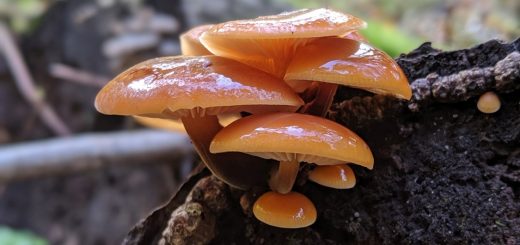

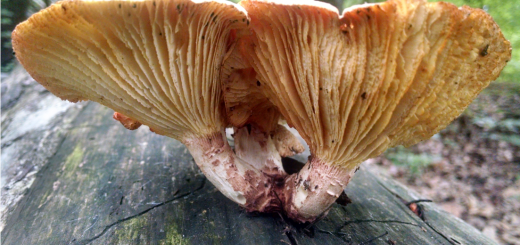





![#011: Characteristics of Kingdom Fungi [Archived]](https://www.fungusfactfriday.com/wp-content/themes/hueman/assets/front/img/thumb-small-empty.png)

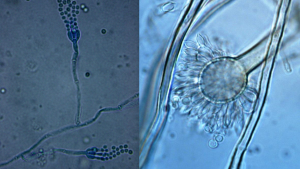
Great article on explaining how to identify the deadly mushroom and how it has similar properties to the death cap.
I really like how you compare it to the common edible ones like the Enoki, Honey Mushroom and even psilocybin mushrooms.
Most people would think about it being similar to magic mushrooms.
I look forward to reading more of your articles!